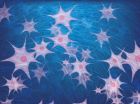(Press-News.org) BUFFALO, N.Y. – Motorists in Los Angeles, San Francisco and other gridlocked cities could learn something from the fruit fly.
Scientists have found that cellular blockages, the molecular equivalent to traffic jams, in nerve cells of the insect's brain can form and dissolve in 30 seconds or less.
The findings, presented in the journal PLOS ONE, could provide scientists much-needed clues to better identify and treat neurodegenerative diseases such as Alzheimer's and Huntington's.
"Our research suggests that fixed, permanent blocks may impede the transport of important cellular components and, ultimately, lead to cellular degeneration and death," says lead researcher Shermali Gunawardena, PhD, an assistant professor of biological sciences in the University at Buffalo's College of Arts and Sciences. "Conversely, blocks that resolve themselves may be benign."
She continues: "This is an important distinction that could help researchers decide which kind or type of blocks to focus on when developing drugs and other forms of therapy for some of these debilitating diseases."
Scientists have long known that many essential cellular components are transported along tracts of nerve cells called neuronal pathways, and that these movements are required for the growth, function and maintenance of neurons. Only recently, however, have they been able to understand the many proteins that help control these movements.
In the UB study, researchers examined isolated nerve cells from fruit fly larvae. Neuronal pathways of these larvae are similar to neuronal pathways in humans.
Traditionally, researchers have identified blockages through still images of dead larvae. These images provide a snapshot only, instead of a depiction of the behavior of the accumulated components over distinct periods of time.
UB researchers altered the approach by analyzing the neuronal pathways of living larvae. Unlike the still images, this method shows how the transport of components changes as neuronal pathways evolve over time.
The researchers found that certain blockages form and dissolve rather quickly. For example, one blockage appeared and disappeared within 29 seconds. Its relatively short life, Gunawardena said, indicates that the blockage is likely benign and not harmful to the cell.
A video showing a blockage that forms and dissolves rapidly can be found here: http://www.buffalo.edu/news/releases/2014/06/009.html.
The distinction is significant, she said, because it could allow researchers to focus on permanent blockages that likely halt cellular movement and may pose more serious health risks.
Researchers also looked at how the transport of essential materials over several days contributed to the growth of neurons. If transport was disrupted, growth of the neuron was compromised. As the neuron grew, the movement of some components carrying synaptic proteins increased while other components did not show significant changes.
This suggests that the transport of components in neuronal pathways is linked to the growth and function of the nerve cell.
Taken together, the findings suggest that more research must be conducted to better understand the spatial and temporal characteristics of how essential materials are transported within neurons of living organisms. This, in turn, will provide clues into how defects in this system can lead to neurodegenerative diseases and, perhaps, better ways to identify and treat these ailments.
INFORMATION:
Co-authors of the study are Gary J. Iacobucci, a graduate student in UB's neuroscience program; Noura Abdel Rahman, a UB graduate who volunteered in Shermali's lab; Aida Andrades Valtuena, an exchange student from Spain; and Tapan Kumar Nayak, postdoctoral research at UB.
The work was partially funded by the National Institutes of Health.
Brain traffic jams that can disappear in 30 seconds
New study finds that blockages in fruit fly brains quickly form and dissolve; it could help treat Alzheimer's and Huntington's diseases
2014-06-06
ELSE PRESS RELEASES FROM THIS DATE:
LSU biologist John Caprio, Japanese colleagues identify unique way catfish locate prey
2014-06-06
BATON ROUGE – Animals incorporate a number of unique methods for detecting prey, but for the Japanese sea catfish, Plotosus japonicus, it is especially tricky given the dark murky waters where it resides.
John Caprio, George C. Kent Professor of Biological Sciences at LSU, and colleagues from Kagoshima University in Japan have identified that these fish are equipped with sensors that can locate prey by detecting slight changes in the water's pH level.
A paper, "Marine teleost locates live prey through pH sensing," detailing the work of Caprio and his research partners, ...
Better tissue healing with disappearing hydrogels
2014-06-06
When stem cells are used to regenerate bone tissue, many wind up migrating away from the repair site, which disrupts the healing process. But a technique employed by a University of Rochester research team keeps the stem cells in place, resulting in faster and better tissue regeneration. The key, as explained in a paper published in Acta Biomaterialia, is encasing the stem cells in polymers that attract water and disappear when their work is done.
The technique is similar to what has already been used to repair other types of tissue, including cartilage, but had never ...
Lower asthma risk is associated with microbes in infants' homes
2014-06-06
Infants exposed to a diverse range of bacterial species in house dust during the first year of life appear to be less likely to develop asthma in early childhood, according to a new study published online on June 6, 2014, in the Journal of Allergy and Clinical Immunology.
Children who were neither allergic nor prone to wheezing as three-year-olds were the most likely to have been exposed to high levels of bacteria, and paradoxically, to high levels of common allergens.
In fact, some of the protective bacteria are abundant in cockroaches and mice, the source of these ...
NASA and NOAA satellites eyeing Mexico's tropical soaker for development
2014-06-06
NASA and NOAA satellites are gathering visible, infrared, microwave and radar data on a persistent tropical low pressure area in the southwestern Bay of Campeche. System 90L now has a 50 percent chance for development, according to the National Hurricane Center and continues to drop large amounts of rainfall over southeastern Mexico.
The Atmospheric Infrared Sounder (AIRS) instrument aboard NASA's Aqua satellite gathered infrared data on the developing low on June 5 at 18:59 UTC (2:59 p.m. EDT).
Basically, AIRS looks at the infrared region of the spectrum. In a spectrum, ...
Study shows health policy researchers lack confidence in social media for communication
2014-06-06
Philadelphia – Though Twitter boats 645 million users across the world, only 14 percent of health policy researchers reported using Twitter – and approximately 20 percent used blogs and Facebook – to communicate their research findings over the past year, according to a new study from the Perelman School of Medicine at the University of Pennsylvania. In contrast, sixty-five percent used traditional media channels, such as press releases or media interviews. While participants believed that social media can be an effective way to communicate research findings, many lacked ...
Evolution of a bimetallic nanocatalyst
2014-06-06
Atomic-scale snapshots of a bimetallic nanoparticle catalyst in action have provided insights that could help improve the industrial process by which fuels and chemicals are synthesized from natural gas, coal or plant biomass. A multi-national lab collaboration led by researchers with the U.S. Department of Energy (DOE)'s Lawrence Berkeley National Laboratory (Berkeley Lab) has taken the most detailed look ever at the evolution of platinum/cobalt bimetallic nanoparticles during reactions in oxygen and hydrogen gases.
"Using in situ aberration-corrected transmission electron ...
Tougher penalties credited for fewer casualties among young male drivers
2014-06-06
VIDEO:
A new Western University study led by Dr. Evelyn Vingilis has found a significant decline in speeding-related fatalities and injuries among young men in Ontario since the province's tough extreme...
Click here for more information.
A new study out of Western University (London, Canada) has found a significant decline in speeding-related fatalities and injuries among young men in Ontario since the province's tough extreme speeding and aggressive driving laws were introduced ...
Endoscope with an oxygen sensor detects pancreatic cancer
2014-06-06
JACKSONVILLE, Fla. — June 6, 3014 — An optical blood oxygen sensor attached to an endoscope is able to identify pancreatic cancer in patients via a simple lendoscopic procedure, according to researchers at Mayo Clinic in Florida.
The study, published in GIE: Gastrointestinal Endoscopy, shows that the device, which acts like the well-known clothespin-type finger clip used to measure blood oxygen in patients, has a sensitivity of 92 percent and a specificity of 86 percent.
MULTIMEDIA ALERT: Video and audio are available for download on the Mayo Clinic News Network.
That ...
Magnetic moment of the proton measured with unprecedented precision
2014-06-06
One of the biggest riddles in physics is the apparent imbalance between matter and antimatter in our universe. To date, there is no explanation as to why matter and antimatter failed to completely annihilate one another immediately after the big bang and how the surplus matter was created that went on to form the universe as we know it. Experiments conducted at Johannes Gutenberg University Mainz (JGU) have contributed towards a resolution of this problem. For the first time a direct and high-precision measurement of the magnetic moment of the proton has been conducted ...
A new way to make laser-like beams using 250x less power
2014-06-06
ANN ARBOR – With precarious particles called polaritons that straddle the worlds of light and matter, University of Michigan researchers have demonstrated a new, practical and potentially more efficient way to make a coherent laser-like beam.
They have made what's believed to be the first polariton laser that is fueled by electrical current as opposed to light, and also works at room temperature, rather than way below zero.
Those attributes make the device the most real-world ready of the handful of polariton lasers ever developed. It represents a milestone like none ...
LAST 30 PRESS RELEASES:
How do childcare tax credits affect children’s long-term health?
Can an electronic nose detect indoor mold?
Do natural disasters have long-term impacts on mortality in older adults?
Modification improves sodium‐ion batteries as an alternative to lithium-ion batteries
Parasports provide a range of benefits for people with cerebral palsy
How does grandparental care affect children’s health?
Why are there so many Nordic mediators?
Young shark species more vulnerable to extinction
Mobile fetal heart monitoring linked to fewer newborn deaths in Tanzania
Bluey’s dad offered professorial chair in archaeology at Griffith University
Beyond small data limitations: Transfer learning-enabled framework for predicting mechanical properties of aluminum matrix composites
Unveiling non-thermal catalytic origin of direct current-promoted catalysis for energy-efficient transformation of greenhouse gases to valuable chemicals
Chronic breathlessness emerging as a hidden strain on hospitals
Paleontologists find first fossil bee nests made inside fossil bones
These fossils were the perfect home for ancient baby bees
Not everyone reads the room the same. A new study examines why.
New research identifies linked energy, immune and vascular changes in ME/CFS
Concurrent frailty + depression likely boost dementia risk in older people
Living in substandard housing linked to kids’ missed schooling and poor grades
Little awareness of medical + psychological complexities of steroid cream withdrawal
Eight in 10 trusts caring for emergency department patients in corridors, finds BMJ investigation
NASA’s Webb telescope finds bizarre atmosphere on a lemon-shaped exoplanet
The gut bacteria that put the brakes on weight gain in mice
Exploring how patients feel about AI transcription
Category ‘6’ tropical cyclone hot spots are growing
Video: Drivers struggle to multitask when using dashboard touch screens, study finds
SLU research shows surge in alcohol-related liver disease driving ‘deaths of despair’
Rising heat reshapes how microbes break down microplastics, new review finds
Roots reveal a hidden carbon pathway in maize plants
Membrane magic: FAMU-FSU researchers repurpose fuel cells membranes for new applications
[Press-News.org] Brain traffic jams that can disappear in 30 secondsNew study finds that blockages in fruit fly brains quickly form and dissolve; it could help treat Alzheimer's and Huntington's diseases




